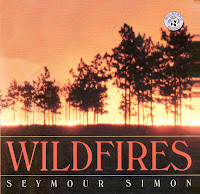Label: Wildfires
December 12, 2017
WILDFIRES: Writing a new NF book for children

The outbreak of fires in California remind me of the photography and research I did before I wrote my book WILDFIRES. I spoke at a conference in Fresno and decided to photograph nature in nearby Sequoia National Forest and Kings Canyon National Park. While photographing I followed a crew of forest rangers and firefighters clearing brush to retard the growth and speed of any future fires. Sometimes that works, other times there is no stopping the explosive growth of wildfires, which is what’s happing now.

As I wrote in my book, “A raging wildfire is a frightening thing. Living trees burn as fast as cardboard boxes in a bonfire. Flames race through the treetops, sometimes faster than a person can run, burning at temperatures hot enough to melt steel.”
But then I wrote, “But not all fires are bad. Fires in nature can help as well as harm. A burned forest allows young plants to begin growing. And fire is necessary for some trees, such as sequoias, to release their seeds. Instead of being an ending, fire is often a new chapter in the continuing story of the natural world.”
I think that it is a good thing to teach children that in nature, things are often neither good nor evil, but part of the natural rhythms of the world.
Posted by: Seymour Simon
September 7, 2011
Wildfires: What is Going On?!

Wildfires are forces of nature like hurricanes, tornadoes and earthquakes. But unlike most other natural disasters, wildfires can sometimes be prevented or at least controlled more easily. Strangely, fire fighters sometime start fires instead of putting them out. Using a fire starter called a drip torch, fire fighters set small blazes on purpose. These small fires help to control fires already burning or prevent large wildfires from starting by burning away undergrowth and dead wood in the path of a raging fire.
For many years, fire fighters put out natural fires as quickly as possible. But the more that fuel on a forest floor or a dry grassland builds up, the worse a wildfire is going to be. Lack of rain and intense days of high temperatures also contribute to wildfires. That’s what is happening in parts of Texas and California right now. It will take lower temperatures and plentiful rains to finally control these huge blazes.
In the future though, preventative fires need to be put to use before a wildfire even starts. Most scientists say that wildfires are part of nature. The only question is when they will happen and how we deal with them. In areas with people and houses, wildfires have to be brought under control as quickly as possible. But in wilderness areas, wildfires are different. Allowing small fires to burn naturally may be one way to prevent tragedies where human lives are lost and houses burned out. Some states such as Florida burn many acres of grassland in the everglades each year to prevent out-of-control future wildfires.
Photograph from Seymour Simon’s book WILDFIRES.

Posted by: Seymour Simon
February 13, 2009
Helping a koala caught in the Australian wildfires
Terrible wildfires have swept across Victoria, Australia. There are ongoing efforts to save Koalas and other wildlife. Perhaps your class might think of a community project to earn some money to help to save Australian wildlife. There are links on this video that will tell you where to write for further information.
Posted by: Seymour Simon



